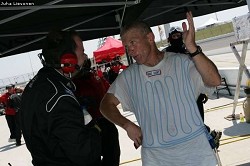 Pics
PicsHome |
 Pics
PicsHome |

Posted (06/15/2009) - For the 4th Straight season, Team Sahlen is utilizing COOL SHIRTS Portable Cooling Systems in their Grand American ROLEX Series Chevrolet Corvettes. "When we used to race Acura Integras and Porsches, the heat in the cars was intense and would really have in impact on the driver over the course of a race. This is especially true since our form of auto racing is Endurance Sports Cars Racing. Sometimes a driver can be in the car for up to 2 hours at a time during our long races that can last as long as 24 hours." - states Will Nonnamaker "But then we started racing Chevrolet Corvettes, and we found out a whole new level of intense heat. You have the heat from the transmission and drive shaft to your right, the heat of the exhaust to your left, and the motor just in front of you. SPEED TV even shared on air that our Driver Cockpit areas were the hottest on the grid. So thanfully, we had our COOL SHIRT System. We utilize both the COOL SHIRT. Now after having experienced the COOL SHIRT system, I wish we would have went to this even when we raced the Acuras, for the benefits in driver durability during a long event." - states Wayne Nonnamaker The History of COOL SHIRT starts with its Founder, Rich Shafer, and his very non racing experiences with dealing with intense pressure in heated conditions. Rich spent countless hours in hospital operating rooms over 20 years selling implants to orthopedic surgeons. He discovered that doctors were overheating during long surgeries due to their protective surgical clothing. "I thought, 'Why not cool the doctors?'", Shafer said. So, he set to work developing a vest that would cool the skin by circulating temperature controlled cool water through tubing sewn to the cloth. In 1994, the first vest appeared in an operating room and Shafer has been a crusader ever since. The reason that he decided to use a vest with water circulating through it is because it has been shown that water cools the body 28 times faster than air. Think about how long it takes to cool off on a hot day when you jump into a swimming pool vs. sitting in an air conditioned room. Shafer is now president of Shafer Enterprises / Cool Shirt, a company that makes many different personal cooling systems for surgeons, race car drivers, industry, firefighters, hazmat teams, football players and other athletes. He preaches the gospel of the effects of body temperature on performance and why it's vitally important to keep the body cool in a hot environment. "NASA conducted a study that states when the temperature around you is 95 degrees for an extended period, people can make 60 mistakes per hour," Shafer said, "And they don't even realize it. When you perspire, almost half of your blood moves to the skin to produce moisture in the form of perspiration to naturally cool the body. The heart is pumping up to 150 beats per minute with less volume to get the blood to the skin. That means the rest of your organs, including the brain and your muscles, are only operating on half the blood they normally need." The same NASA study further showed that by reducing the temperature by just 5 degrees the number of mistakes is reduced to an average of 9 an hour. The human body is very unique on how it deals with heat. All of us are subject to heat stress when we work in a hot environment. The average skin temperature of the human body is between 91° and 92° Fahrenheit. An interesting fact is that when the temperature around us is 70°, about 4% of our total blood supply is going to our skin to release heat. When the temperature around us goes above 70°, we start to sweat to release body heat. Up to 48% of the blood supply flows to the skin to open the pours and produce sweat. This is almost half of your total blood supply which means that now your brain and other vital organs are operating on half of what is needed to function properly. There are four ways to lose body heat when the temperature runs too high. Radiation occurs when the outside temperature becomes lower than the body temperature. Convection is heat loss through air and water vapor that must be a lower temperature than the skin. Conduction transfers heat from warmer to cooler by contact. Evaporation is the cooling effect that occurs when a liquid turns to a vapor and leaves a surface as when perspiration evaporates from the skin's surface. The beginning of heat exhaustion occurs when you lose 2 percent of your body weight through perspiration" says Shafer. Most drivers on a hot summer night will lose at least that much and it is easy to check, just weigh yourself in the morning and again at the end of the night. If you weigh 200 pounds and you lose four pounds at nights end, you are in heat exhaustion. When the temperature gets above 95 degrees, radiation, convection and conduction don't work and perspiration is all you have left and it doesn't work very well inside a driving suit. In fact, most race car interiors are 120°+ and if all you are doing to cool yourself is to blow outside air into the cockpit, then you may just be creating a convection oven to bake yourself in. When half the body's blood moves to the skin to produce perspiration, fatigue and poor decision-making become the greatest dangers to the body. One of the hot set ups currently is to blow cooled air into the helmet. While this may make you feel better it is not truly cooling the body's core. Most of the heat is stored in the trunk of the body, where all the organs are. Further, the body's thermostat is in the middle of the head and if the head is too cold it tells the body to start warming up even if it is already warm. Also remember what was said earlier about water being the most effective way to remove heat from the body and since most of your perspiration is trapped inside your driving suit, the only good way to cool effectively is to get cool water inside your driving suit. Cool Shirt makes a shirt for race drivers that is similar to the vest for surgeons; it has cool water pumping through tubes sewn into it. While staying cool is about safety, it is also about performance. If you can keep yourself out of heat exhaustion by minimizing water loss through perspiration you will stay sharp and be thinking clearly throughout the entire race. This might mean that you see a wreck coming that you can avoid and during the week you can work on improving your car instead of repairing it, or that you are able to get by another car or two for a higher finish. If you would like more information on staying cool in your race car visit our website at coolshirt.net. The 2009 Team Sahlen ROLEX GT Campaign is support by HRPWorld.com, Cool Shirt, HAWK Performance, Forgeline Wheels, TheRaceSite.com, TheRaceMarket.com, Grassroots Motorsports Magazine, Holliday Canopies, Alcon, CM |
|
Most Recent News Articles ** Team Sahlen's Joe Nonnamaker - Nelson Ledges 24 hours from 1980 to 2019 ** Team Sahlen has a great day of Testing at Nelson Ledges Road Course ** Audi Mentor mentors Team Sahlen on new Audi R8 LMS GT3 ** Team Sahlen excitedly announces their newest racer - the Audi R8 LMS GT3 ** ECS Tuning welcomes new partnership with Team Sahlen ** All Fit Automotive helps Team Sahlen improve their Race Cars' Aerodynamics ** Team Sahlen secures Double OVERALL victory at the Sahlen's Champyard DOG at the Glen ** Team Sahlen secures photo finish 1st and 2nd Place at the Sahlen's Sports Car Springfest at the Glen ** Team Sahlen excited for Memorial Day weekend at the Watkins Glen International ** The Sahlen's Sports Car Springfest kicks off the racing season at Watkins Glen International ** Team Sahlen kicks off season at Watkins Glen International |